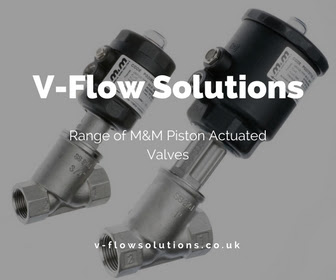M&M Piston Valves in Kerosene Filling Applications
Piston actuated valves are suitable for a wide variety of applications. In this blog post we will look at an example of their use in a kerosene filling rig and the type of piston actuated valve we would recommend for the application.
Piston actuated valves used in kerosene filling rigs:
The kerosene filling injection unit is used to fill thermic probes with kerosene. The system consists of an injection unit. a cooling system, a vacuum pump, a pressure pump and a kerosene tank. The system contains three piston actuated valves as shown in the diagram below.
1st stage – Vacuum
The probe connects to the fast connection nozzle (Q). When the vacuum pump starts (V) piston actuated valve (A) opens and creates a -0.2 bar depression inside the probe to prevent air bubbles from forming during filling operations.
2nd stage – Filling
A pump (P) controls the tank, which contains Kerosene (at room temperature). This then travels to the filling unit. Piston actuated valve (A) closes and valve (B) opens to let kerosene into the probe. When it is full, the tightness of the probe is tested up to 6 bar pressure.
3rd stage – Exhaust of the injection unit
When filling is over, the probe is disconnected from the injection unit, valve (B) closes, valve (A) reopens and the vacuum pump (V) starts, creating a depression inside the circuit. Kerosene left inside the unit is sucked up and sent into a heat exchanger to be cooled up to –30° and brought back to a liquid state. Valve (C) installed at the bottom of the heat exchanger opens at the end of the day and kerosene exhausts into a collecting tank. Then the piping system carries the kerosene back into the main tank.
The valve that we would recommend for this application is:

You can view the V-Flow Solutions range of M&M Piston actuated valves here:
V-Flow Solutions: Piston Valves
M&M Angle seat piston valves
M&M piston valves are manufactured in Italy, using the highest quality materials for a high-quality product.
Piston actuated valves use an external control media to pilot the actuator, where a piston valve connects directly to the main seal that closes onto the main orifice, thereby controlling the flow of liquids and gases.
M&M piston valves are highly recommended under these conditions:
- Media containing dirt particles
- Highly viscous media (up to 600 cST (80°E); 1 centistoke = 1 mm2/s)
- High flow volumes
- High temperatures
- Damp environments or hazardous locations
The versions of M&M Piston actuated valves available are:
| | |
| | |
Technical Information
The main seal material used in piston actuated valves:
A modified PTFE has been the main seal material since 2004 when it replaced the original PTFE material seal.
The modified PTFE seal provides these benefits over the previous version:
- Lower porosity and permeability
- Fewer void spaces
- Higher elasticity
- Reduced deformation under load
- Better chemical resistance to controlled media
- Smoother surface and improved design flexibility
The standard bonnet seals consist of 2 ‘V’-shaped FKM gaskets and a package of 25% graphite-filled PTFE gaskets.
High-temperature Piston actuated valves:
M&M can offer a piston valve that can be used up to 200°C, provided that the valve pressure limits are respected.
The main differences, in regards to the materials in this design, are as follows:
- Change of the actuator material: From standard PA6 to PA66 filled with 30% fibreglass
- All valves with DN > 25 with fixed plug design (to withstand turbulence caused by steam at high speed)
- Special design of bonnet chevrons, all are made of 25% graphite-filled PTFE
10 Reasons to use a piston actuated valve:
You can view piston actuated valves here, on our website:
V-Flow Solutions Piston Valves
For any other products please look on our website:
If you think V-Flow can help you then please contact us:
Telephone: +44 (0)1234 855888
Email: sales@v-flowsolutions.co.uk
Fax: +44 (0)1234 857775











